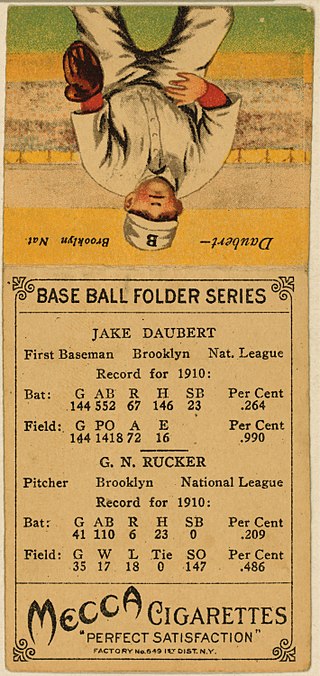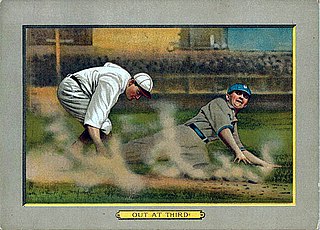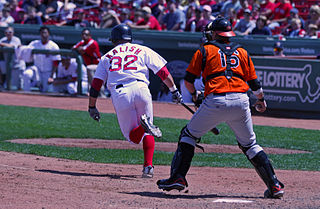
Baseball statistics refers to a variety of metrics used to evaluate player and team performance in the game of baseball.

In baseball statistics, a hit, also called a base hit, is credited to a batter when the batter safely reaches or passes first base after hitting the ball into fair territory with neither the benefit of an error nor a fielder's choice.

Softball is a popular variation of baseball, the difference being that it is played with a larger ball on a smaller field and with only underhand pitches permitted. Softball is played competitively at club levels, the college level, and the professional level. The game was first created in 1887 in Chicago by George Hancock.

In baseball or softball, a strikeout occurs when a batter accumulates three strikes during a time at bat. It means the batter is out, unless the third strike is not caught by the catcher and the batter reaches first base safely as a result. A strikeout is a statistic recorded for both pitchers and batters, and is usually denoted by the letter K, or sometimes by the initialism SO. A "strikeout looking"—in which the batter does not swing and the third strike is called by the umpire—may be denoted by an inverted K.

In baseball, an intentional base on balls, usually referred to as an intentional walk and denoted in baseball scorekeeping by IBB, is a walk issued to a batter by a pitcher with the intent of removing the batter's opportunity to swing at the pitched ball. A pitch that is intentionally thrown far outside the strike zone for this purpose is referred to as an intentional ball.

In baseball, an out occurs when the umpire rules a batter or baserunner out. When a batter or runner is out, they lose their ability to score a run and must return to the dugout until their next turn at bat. When three outs are recorded in a half-inning, the batting team's turn expires.

Throughout the history of baseball, the rules have frequently changed as the game continues to evolve. A few common rules most professional leagues have in common is that four balls is a base on balls, three strikes is a strikeout, and three outs end a half-inning.
In baseball statistics, strikeout-to-walk ratio (K/BB) is a measure of a pitcher's ability to control pitches, calculated as strikeouts divided by bases on balls.

Baseball scorekeeping is the practice of recording the details of a baseball game as it unfolds. Professional baseball leagues hire official scorers to keep an official record of each game, but many fans keep score as well for their own enjoyment. Scorekeeping is usually done on a printed scorecard and, while official scorers must adhere precisely to one of the few different scorekeeping notations, most fans exercise some amount of creativity and adopt their own symbols and styles.

In baseball and softball, an uncaught third strike occurs when the catcher fails to cleanly catch a pitch for the third strike of a plate appearance. In Major League Baseball (MLB), the specific rules concerning the uncaught third strike are addressed in Rules 5.05 and 5.09 of the Official Baseball Rules:
In baseball, a control pitcher, also known as a finesse pitcher, is a pitcher who succeeds mostly by using accurate pitches, as opposed to a power pitcher who relies on velocity. By issuing a below average number of bases on balls they exhibit good control of their pitches. Pitchers with good control are said to be able to throw all the pitches in their repertoire for strikes in different locations regardless of the batter, count and score. According to Curt Schilling, "Control is the ability to throw strikes, and command is the ability to throw quality strikes." Another definition of control is "The ability to deliver the ball to the plate with accuracy." The best control pitchers will walk as few as one batter per game. Control is also key to getting ahead in the count, and thus gaining the advantage over batters to keep them off base. Statistics used to measure control include:
The 1971 Detroit Tigers finished in second place in the American League East with a 91–71 record, 12 games behind the Orioles. They outscored their opponents 701 to 645. They drew 1,591,073 fans to Tiger Stadium, the second highest attendance in the American League.
The 1974 Detroit Tigers compiled a record of 72–90. They finished in last place in the American League East, 19 games behind the Baltimore Orioles. They were outscored by their opponents 768 to 620.
The Tigers entered the season as the reigning World Series champions. The 1985 Detroit Tigers finished in third place in the American League East with a record of 84–77 (.522), 15 games behind the Blue Jays. The Tigers outscored their opponents 729 to 688. The Tigers drew 2,286,609 fans to Tiger Stadium in 1983, ranking 3rd of the 14 teams in the American League.
In the 1944 Negro World Series, the Washington Homestead Grays, champions of the Negro National League were matched against the Birmingham Black Barons, champions of the Negro American League, for the second year in a row. The Grays won the series again, four games to one.
In the 1945 Negro World Series, the Cleveland Buckeyes, champions of the Negro American League, swept the Washington Homestead Grays, champions of the Negro National League, four games to none.
In the 1946 Negro World Series, the Newark Eagles, champions of the Negro National League, beat the Kansas City Monarchs, champions of the Negro American League, four games to three.
The 1927 Colored World Series was the championship tournament for the 1927 season of Negro league baseball. It was the fourth overall Series played. It matched the Chicago American Giants, champions of the Negro National League (1920–1931) and the Bacharach Giants of Atlantic City, New Jersey, champions of the Eastern Colored League. The Giants won the series five games to three. The two teams had faced a year earlier in the 1926 Colored World Series with the same result.

Vitilla is a popular variation of stickball played primarily in the Dominican Republic and areas in the United States with large Dominican populations.









